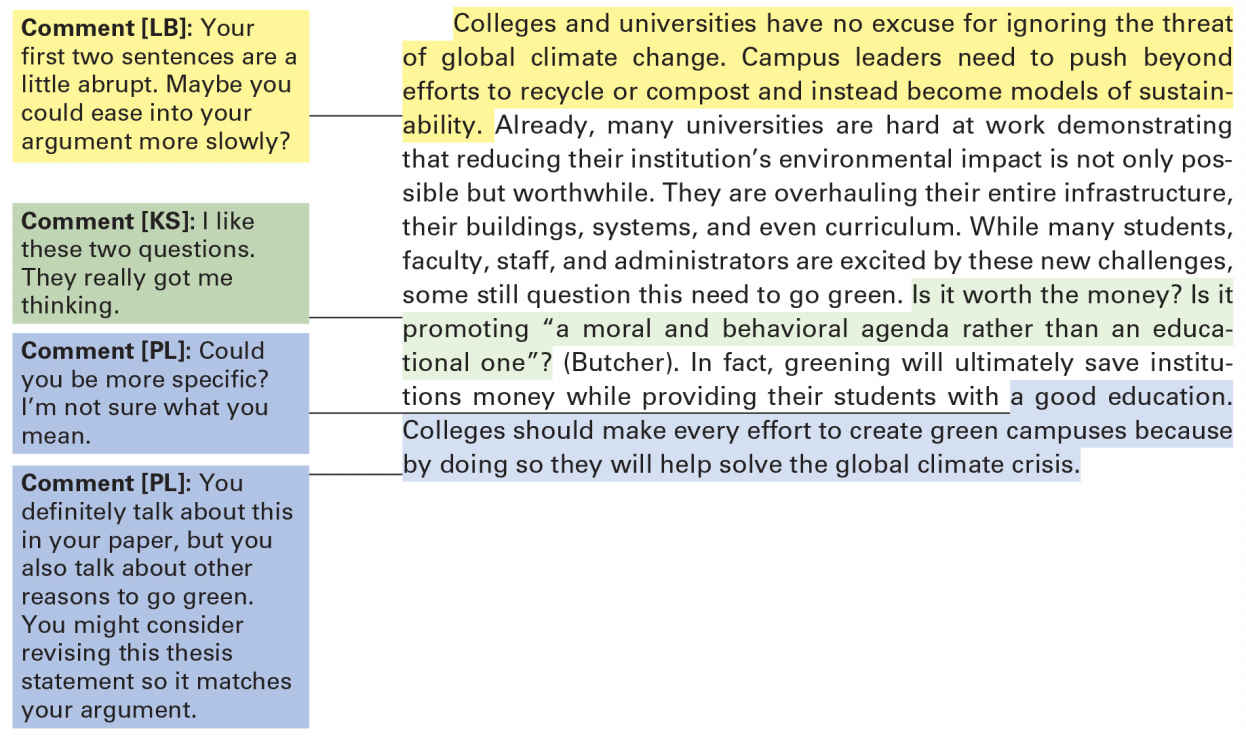Revising Your Essay
After you have written a draft of your essay, you will need to revise it. Revision is “re-seeing” —looking carefully and critically at the draft you have written. Revision is different from editing and proofreading (discussed on p. 278), which focus on grammar, punctuation, mechanics, and the like. In fact, revision can involve substantial reworking of your essay’s structure and content. The strategies discussed on the pages that follow can help you revise your arguments.
Asking Questions
Asking some basic questions, such as those in the three checklists that follow, can help you as you revise.
The answers to the questions in the checklists may lead you to revise your essay’s content, structure, and style. For example, you may want to look for additional sources that can provide the kind of supporting evidence you need. Or, you may notice you need to revise the structure of your essay, perhaps rearranging your points so that the most important point is placed last, for emphasis. You may also want to revise your essay’s introduction and conclusion, sharpening your thesis statement or adding a stronger concluding statement. Finally, you may decide to add more background material to help your readers understand the issue you are writing about or to help them take a more favorable view of your position.
Using Outlines and Templates
To check the logic of your essay’s structure, you can prepare a revision outline or consult a template.
To make sure your essay’s key points are arranged logically and supported convincingly, you can construct a formal outline of your draft. (See p. 267 for information on formal outlines.) This outline will indicate whether you need to discuss any additional points, add supporting evidence, or refute an opposing argument more fully. It will also show you if paragraphs are arranged in a logical order.
To make sure your argument flows smoothly from thesis statement to evidence to refutation of opposing arguments to concluding statement, you can refer to one of the paragraph templates that appear throughout this book. These templates can help you to construct a one-paragraph summary of your essay.
Getting Feedback
After you have done as much as you can on your own, it is time to get feedback from your instructor and (with your instructor’s permission) from your school’s writing center or from other students in your class.
Instructor Feedback You can get feedback from your instructor in a variety of different ways. For example, your instructor may ask you to email a draft of your paper to him or her with some specific questions (“Do I need paragraph 3, or do I have enough evidence without it?” “Does my thesis statement need to be more specific?”). The instructor will then reply with corrections and recommendations. If your instructor prefers a traditional face-to-face conference, you may still want to email your draft ahead of time to give him or her a chance to read it before your meeting.
Writing Center Feedback You can also get feedback from a writing center tutor, who can be either a student or a professional. The tutor can give you another point of view about your paper’s content and organization and also help you focus on specific questions of style, grammar, punctuation, and mechanics. (Keep in mind, however, that a tutor will not edit or proofread your paper for you; that is your job.)
Peer review Finally, you can get feedback from your classmates. Peer review can be an informal process in which you ask a classmate for advice, or it can be a more structured process, involving small groups working with copies of students’ work. Peer review can also be conducted electronically. For example, students can exchange drafts by email or respond to one another’s drafts that are posted on the course website. They can also use Word’s comment tool, as illustrated in the following example.
DRAFT

FINAL VERSION
Over the last few years, the pressure to go green has led colleges and universities to make big changes. The threats posed by global climate change are inspiring campus leaders to push beyond efforts to recycle to become models of sustainability. Today, in the interest of reducing their environmental impact, many campuses are seeking to overhaul their entire infrastructure—their buildings, their systems, and even their curriculum. While many students, faculty, staff, and administrators are excited by these new challenges, some question this need to go green. Is it worth the money? Is it promoting “a moral and behavioral agenda rather than an educational one”? (Butcher). In fact, greening will ultimately save institutions money while providing their students with the educational opportunities necessary to help them solve the crisis of their generation. Despite the expense, colleges should make every effort to create green campuses because by doing so they will improve their own educational environment, ensure their own institution’s survival, and help solve the global climate crisis.
Adding Visuals
After you have gotten feedback about the ideas in your paper, you might want to consider adding a visual —such as a chart, graph, table, photo, or diagram—to help you make a point more forcefully. For example, in a paper on the green campus movement, you could include anything from photos of students recycling to a chart comparing energy use at different schools. Sometimes a visual can be so specific, so attractive, or so dramatic that its impact will be greater than words would be. At other times, a visual can expand and support a verbal argument.
You can create a visual yourself, or you can download one from the Internet, beginning your search with Google Images. If you download a visual and paste it into your paper, be sure to include a reference to the visual in your discussion to show readers how it supports your argument.